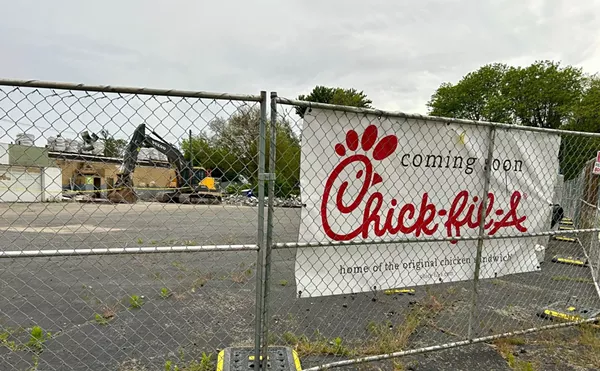
Audio By Carbonatix
[
{
"name": "GPT - Leaderboard - Inline - Content",
"component": "35519556",
"insertPoint": "5th",
"startingPoint": "3",
"requiredCountToDisplay": "3",
"maxInsertions": 100,
"adList": [
{
"adPreset": "LeaderboardInline"
}
]
}
]
The 2007 inspection report released last week finding the Ambassador Bridge in "fair condition" was mostly unremarkable, save for a few descriptions of the "poor condition" of certain sections outside of the primary structural parts.
The color photos of cracks and missing bolts made for good TV.
Since the report's release, bridge company employees have continued to complain that it was made public at all.
"The regulations don't require that," says Phil Frame, spokesman for the Detroit International Bridge Company, the Warren-based owner of the Ambassador Bridge.
Rep. Rashida Tlaib (D-Detroit), who is never shy about criticizing the bridge company's methods, applauds the release. "It's alarming to me that all this has been kept secret," says Tlaib, whose district encompasses the bridge's approach and the surrounding neighborhood.
The bridge company's inspection reports — paid for by the company, which declined to release its costs — are submitted to the Michigan Department of Transportation and the Federal Highway Authority.
State law allows the inspection reports to remain exempt from public disclosure. Federal law, however, does not. Which is why U.S. Rep. John Dingell (D-Dearborn) was able to get the document after filing a Freedom of Information Act request with FHA in February.
Meanwhile, the company fought the report's release to the general public. Last week U.S. District Judge Patrick Duggan denied the company's motion to block the disclosure. Dingell, who had postponed public release of his copy of the report until Duggan's ruling, quickly provided access to the media and posted its introduction and summary on his website.
The company claimed release of the report would both provide proprietary information to its competitors and pose a security risk, since the report contained highly detailed information about the bridge's design.
"No public bridge or any other facility for that matter releases that information," Frame says.
But Duggan ruled that the public's right to know the condition of the bridge outweighed the bridge company's fears.
What exactly those security fears are hasn't been addressed. In fact, the report itself recommends the bridge company "consider a security assessment study for the bridge to primarily identify any existing component vulnerabilities and to develop countermeasures as needed for the vulnerabilities in conjunction with existing security measures."
Bridge officials did not respond to Metro Times questions about whether such an assessment was done. Since 2001, the bridge company has been using national security concerns to justify its actions, including sealing off part of the city-owned Riverside Park adjacent to the bridge.
Let's pause a moment to appreciate the full irony of that: The company that's been justifying its illegal occupation of city parkland by repeatedly and dramatically claiming in court that it just had to do so because of how important it considers protecting the bridge from would-be bin Ladens — as of 2007, at least which, by our count is a full six years after 9/11 — hadn't quite found the time or money to, you know, conduct an actual security assessment.
Dingell, meanwhile, is now seeking the 2008 and 2009 inspection reports, which he also intends to make public. "I make no allegations about the safety or lack of safety of the bridge," says the congressman. "One of the reasons I'm releasing this is so that smarter people than John Dingell can look at it and arrive at better and informed judgments."
Following his remarks, the bridge company released correspondence related to the 2008 and 2009 reports which state that the span remains in fair condition but with parts of its concrete deck, some roadway joints, joists in the approach span and sidewalks in poor condition.
Sherif El-Tawil, professor of structures and materials engineering at University of Michigan, thinks the "overall fair" rating was generous, given the deterioration of the deck and the cracking or chipping found in the primary structural elements. "It seems to me that it would be in the poor or serious [category]," he says.
Frame says the report is inconsequential to the company's future plans for a second crossing. "We would want to go ahead with the second span no matter what condition the Ambassador Bridge is in," he says.
That's odd, because we seem to recall the company claiming that the whole reason for wanting to build the new bridge was because the old one was crumbling.
Bridge owners have proposed building a six-lane, cable-stay bridge alongside the existing four-lane span. "The Ambassador Bridge would still be there and would still be used," Frame says. "Let's say there's some kind of spike in traffic because of some event or something else going on. … Maybe years in the future when the traffic increases when economic activity is not so depressed and things come back, it would be available."
The lifespan of suspension bridges like the Ambassador, built in 1929, isn't really known, says Tapan Datta, professor of civil engineering and director of the Transportation Research Group at Wayne State University. "The question is," he says, about the Ambassador, "how much maintenance can be done to continue to use it?"
News Hits is edited by Curt Guyette. Contact him at 313-202-8004 or NewsHits@metrotimes.com




